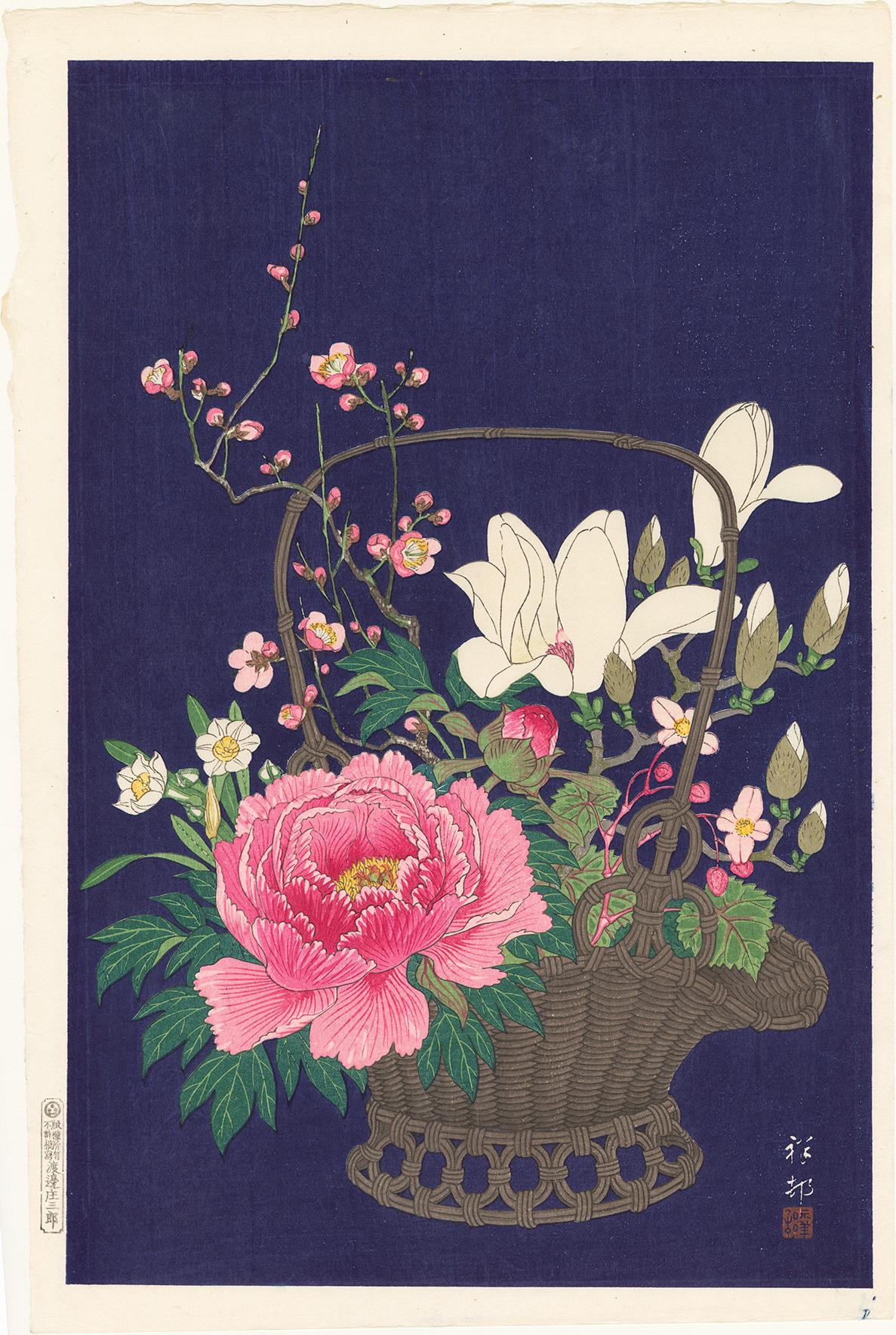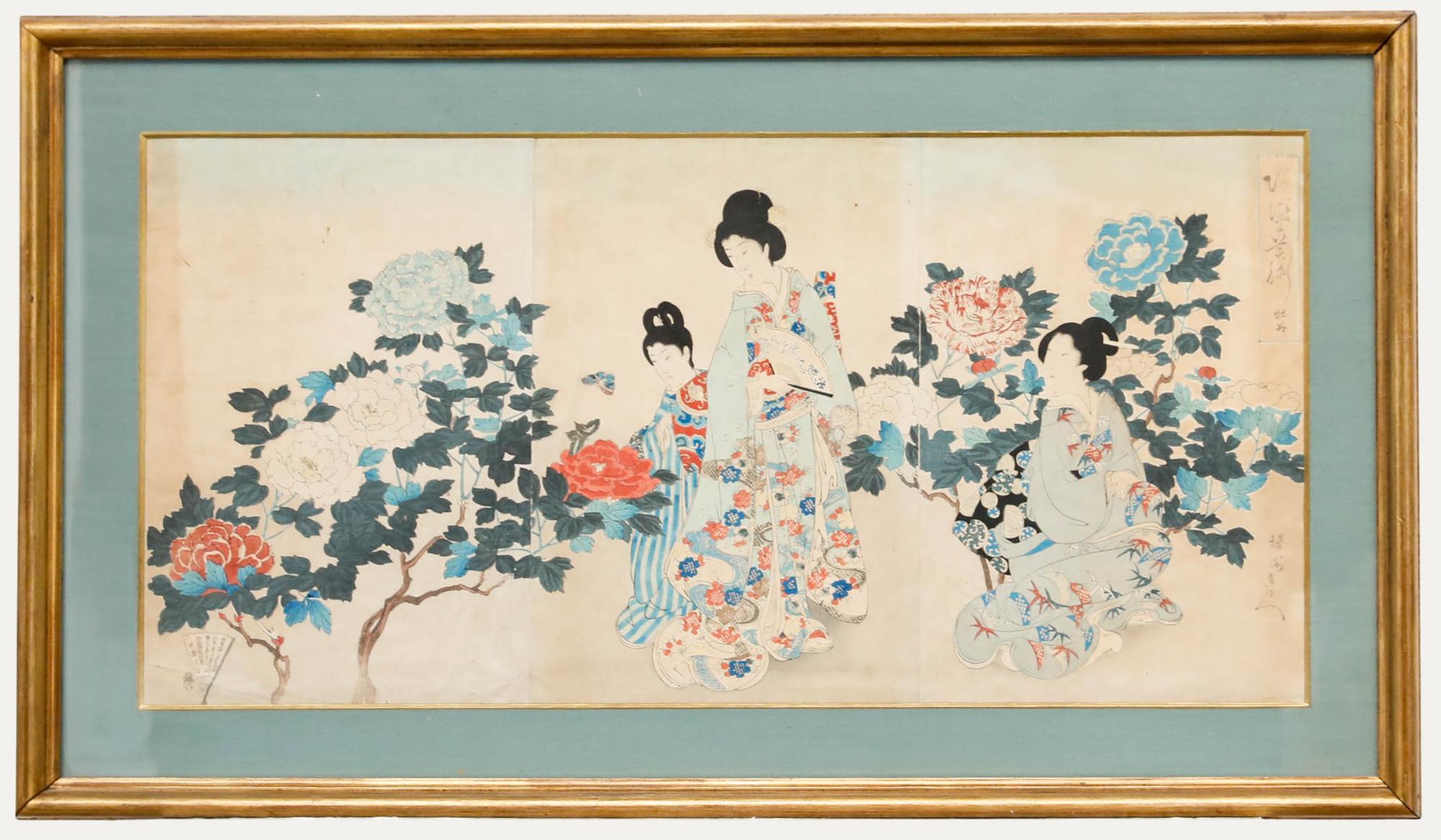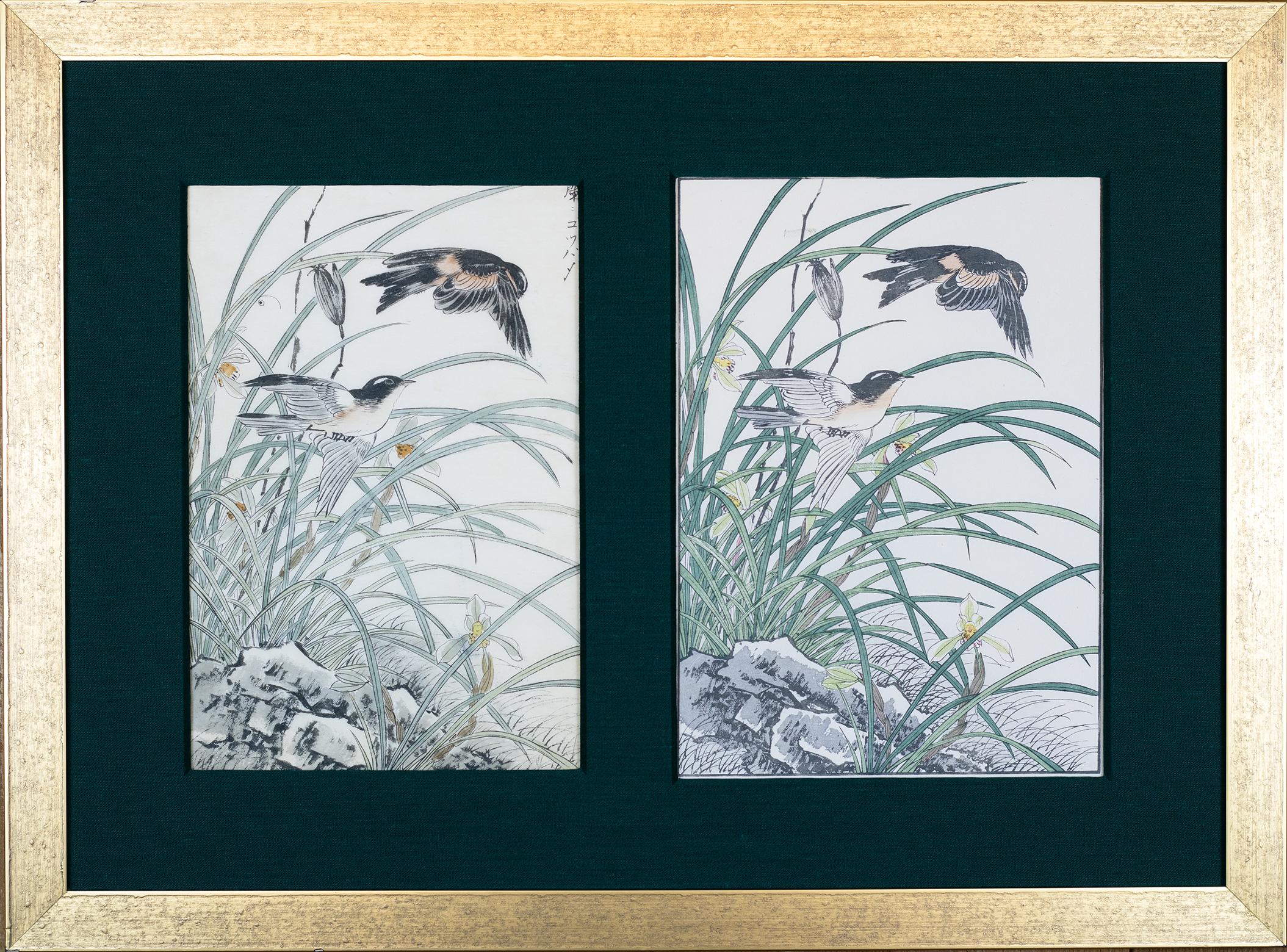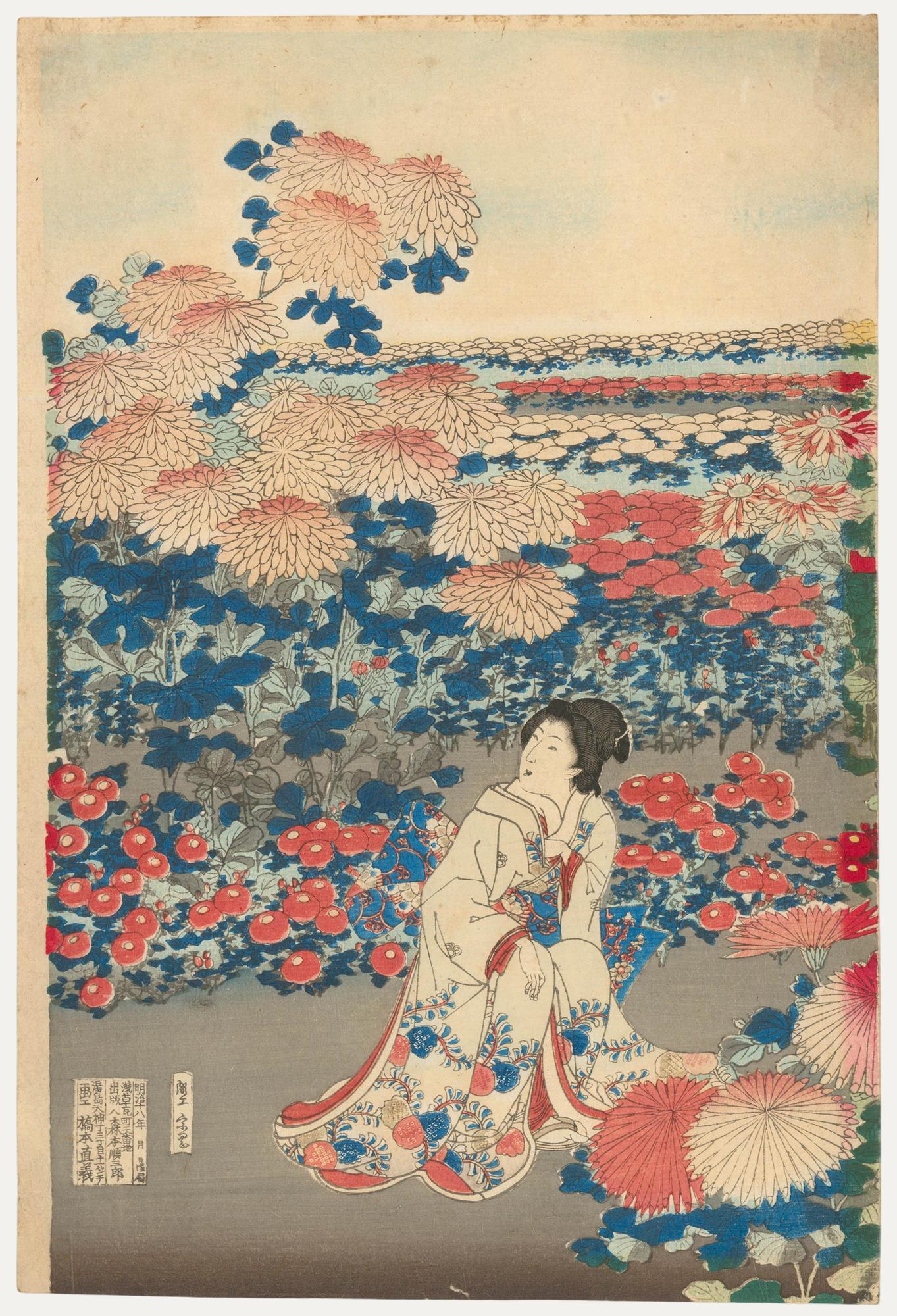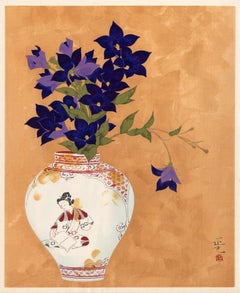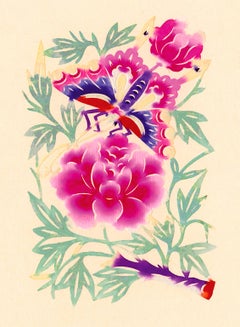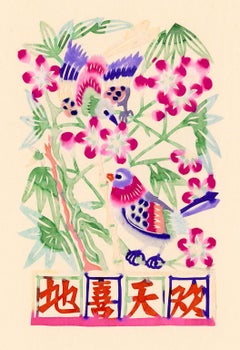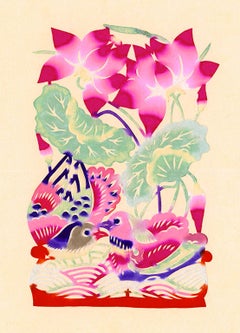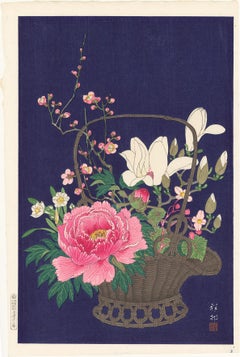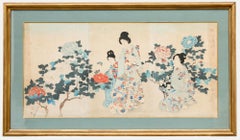Items Similar to Tree Peony and Blue and White Flycatcher — 19th century woodblock print
Want more images or videos?
Request additional images or videos from the seller
1 of 6
Imao KeinenTree Peony and Blue and White Flycatcher — 19th century woodblock print1882
1882
$440
$55020% Off
£335.60
£419.5020% Off
€382.17
€477.7120% Off
CA$618.33
CA$772.9220% Off
A$674.38
A$842.9820% Off
CHF 357.24
CHF 446.5520% Off
MX$8,084.86
MX$10,106.0820% Off
NOK 4,549.67
NOK 5,687.0820% Off
SEK 4,160.33
SEK 5,200.4120% Off
DKK 2,855.18
DKK 3,568.9720% Off
About the Item
Imao Keinen, 'Tree Peony and Blue and White Flycatcher' from the series 'Birds and Flowers of the Four Seasons', color woodblock Oban diptych, 1882. A fine impression, with fresh colors, on cream Japan paper, in excellent condition. Archivally matted to museum standards, unframed.
Image size: diptych 12 5/8 x 17 7/8 inches (321 x 452 mm).
ABOUT THE ARTIST
Born in Kyoto, Imao Keinen (1845-1924) studied painting and calligraphy with Umegata Tokyo and Suzuki Hyakunen. He taught at the Kyoto Prefecture School of Painting and exhibited in shows in Japan and Paris. One of the most well-known Japanese painters of his time, Keinen was honored by his country with the title of 'Artist of the Japanese Empire' and with membership in the Imperial Fine Arts Academy in 1919.
Imao Keinen’s most famous work, 'Keinen Kacho Gafu', is an extensive series of 160 woodblock prints of birds and flowers, published in 1891 in four volumes of 40 prints, one for each of the four seasons. The subjects range from large birds of prey to beautiful songbirds, each realistically depicted with the flowering plants and trees of their native habitat—the lyrically designed works rendered in a natural, soft color palette. These exceptionally fine nature prints, produced in the traditional Japanese vertical Oban format, were published by Nishimura Soemon, with the blocks carved by Tanaka Hirokichi and printed by Miki Jinzaburo.
- Creator:Imao Keinen (1845 - 1924, Japanese)
- Creation Year:1882
- Dimensions:Height: 12.63 in (32.09 cm)Width: 17.88 in (45.42 cm)
- Medium:
- Movement & Style:
- Period:
- Condition:
- Gallery Location:Myrtle Beach, SC
- Reference Number:Seller: 969351stDibs: LU53239479932
About the Seller
5.0
Recognized Seller
These prestigious sellers are industry leaders and represent the highest echelon for item quality and design.
Platinum Seller
Premium sellers with a 4.7+ rating and 24-hour response times
Established in 1995
1stDibs seller since 2016
334 sales on 1stDibs
Typical response time: 1 hour
Associations
International Fine Print Dealers Association
- ShippingRetrieving quote...Shipping from: Myrtle Beach, SC
- Return Policy
More From This Seller
View All'Flowers and Ko-Imari' — Taisho/Showa Shin Hanga Woodblock Print
Located in Myrtle Beach, SC
Masami Iwata, 'Flowers and Ko-Imari', color woodblock print, c. 1960, edition 250. Signed, and with the artist’s seal, lower right. A superb, painterly impression, with fresh colors,...
Category
1960s Modern Still-life Prints
Materials
Woodcut
Butterfly & Flowers 1 — Hopei Folk Art, Mid-Century Chinese Cut Paper Watercolor
Located in Myrtle Beach, SC
'Butterfly & Flowers', Chinese Hopei Folk Art, 1956. Paper-cut with watercolor, mounted on cream, wove backing paper, with fresh, vivid colors, in excellent condition. Matted to museum standards, unframed.
Image size 4 5/8 x 3 1/8 inches; sheet size 8 7/8 x 6 1/4 inches; mat size 14 x 11 inches.
ABOUT THIS WORK
Hopei or Hebei is a province of North East China, on the Gulf of Chihli near Beijing that is home to Chengde Mountain Resort, the imperial summer residence of the Qing-dynasty emperors. Chengde contains 18th-century palaces, gardens, and pagodas ringed...
Category
Mid-20th Century Folk Art Figurative Drawings and Watercolors
Materials
Watercolor
Birds & Flowers 2 — Hopei Folk Art, Mid-Century Chinese Cut Paper and Watercolor
Located in Myrtle Beach, SC
'Birds & Flowers', Chinese Hopei Folk Art, 1956. Paper-cut with watercolor, mounted on cream, wove backing paper, with fresh, vivid colors, in excellent condition. Matted to museum standards, unframed.
Image size 4 7/8 x 3 1/8 inches; sheet size 8 7/8 x 6 1/4 inches; mat size 14 x 11 inches.
ABOUT THIS WORK
Hopei or Hebei is a province of North East China, on the Gulf of Chihli near Beijing that is home to Chengde Mountain Resort, the imperial summer residence of the Qing-dynasty emperors. Chengde contains 18th-century palaces, gardens, and pagodas ringed...
Category
Mid-20th Century Folk Art Figurative Drawings and Watercolors
Materials
Watercolor
Birds & Flowers — Hopei Folk Art, Mid-Century Chinese Cut paper and Watercolor
Located in Myrtle Beach, SC
'Birds & Flowers', Chinese Hopei Folk Art, 1956. Paper-cut with watercolor, mounted on cream, wove backing paper, with fresh, vivid colors, in excellent condition. Matted to museum s...
Category
Mid-20th Century Folk Art Figurative Drawings and Watercolors
Materials
Watercolor
Butterfly & Flowers 2 — Hopei Folk Art, Mid-Century Chinese Cut Paper Watercolor
Located in Myrtle Beach, SC
'Butterfly & Flowers', Chinese Hopei Folk Art, 1956. Paper-cut with watercolor, mounted on cream, wove backing paper, with fresh, vivid colors, in excellent condition. Matted to museum standards, unframed.
Image size 5 1/8 x 3 1/8 inches; sheet size 8 7/8 x 6 1/4 inches; mat size 14 x 11 inches.
ABOUT THIS WORK
Hopei or Hebei is a province of North East China, on the Gulf of Chihli near Beijing that is home to Chengde Mountain Resort, the imperial summer residence of the Qing-dynasty emperors. Chengde contains 18th-century palaces, gardens, and pagodas ringed...
Category
Mid-20th Century Folk Art Figurative Drawings and Watercolors
Materials
Watercolor
'Inside the Flowers' (Java Sparrow and Peach Blossoms) — Mid-Century Japanese
Located in Myrtle Beach, SC
Shoko Uemura, 'Inside the Flowers (Java Sparrow and Peach Blossoms)', color woodcut, c. 1950s, edition 300. Signed in ink with the artist’s red seal beneath. A superb impression, with fresh, delicate colors, on cream wove Japan paper; the full sheet with margins (9/16 to 1 3/8 inches), in excellent condition. Archivally sleeved, unmatted.
Image size 12 3/4 x 18 1/2 inches (324 x 470 mm); sheet size 14 3/4 x 20 3/16 inches (375 x 513 mm).
Published by The Momose Print Company of Tokyo.
ABOUT THE ARTIST
Uemura Shoko (1902-2001) was the son of the famous shin-hanga artist Uemura Shoen...
Category
1950s Showa Animal Prints
Materials
Woodcut
You May Also Like
Authentic "Bullfinch and Weeping Cherry" by master printer 高見澤忠雄 Tadao M.
By Katsushika Hokusai
Located in London, GB
This authentic woodblock print is titled, Uso shidare-zakura 鷽 垂桜 (Bullfinch and weeping cherry-tree). It is printed and published by Ukiyoe Kenkyusho studio, known for making authen...
Category
1950s Edo Landscape Prints
Materials
Handmade Paper, Ink
Authentic Japanese Woodblock Print-Birds and Flowers-Edo-Fan Re-carved 1920s
By Utagawa Sadahide
Located in London, GB
This rare Original 1920s authentic print is a Taisho Period Woodblock print published from the Japan 1920's The Nippon Mokuhan Gasui, Masterpieces Series.;
it is authentically hand ...
Category
1920s Landscape Paintings
Materials
Ink, Handmade Paper
Flower Basket Arrangement against an Indigo Background (First Edition)
By Ohara Koson
Located in Burbank, CA
A basket with carefully arranged flowers is contrasted against a dramatic blue-black background. The showcased ikebana basket (kago) is in a traditional style of the early Showa peri...
Category
Mid-20th Century Showa Still-life Prints
Materials
Mulberry Paper, Woodcut
Yoshu Chikanobu (1838-1912) - Japanese Woodblock, Amongst the Flowers Triptych
By Yoshu Chikanobu
Located in Corsham, GB
A delightful triptych by the Japanese ukiyo-e artist Yoshu Chikanobu (1838-1912). The three sections combine to make a single image of women in richly decorated kimonos surrounded by...
Category
19th Century Figurative Prints
Materials
Woodcut
Original Japanese Watercolor and Woodblock Print of Orchid and Swallows
Located in Burbank, CA
Orchid and small swallows (Hokuri, kotsubame). Original preparatory watercolor next to the finished original Japanese woodblock print. This is a highly finished preparatory watercolo...
Category
1890s Art Deco Animal Drawings and Watercolors
Materials
Watercolor, Woodcut
$1,900 Sale Price
32% Off
Atrib. Hashimoto Naoyoshi (1838-1912) - Japanese Woodblock, In the Flower Garden
Located in Corsham, GB
Delightful Japanese woodblock print, depicting a young woman in a garden full of flowers. Signed and inscribed with characters. On laid.
Category
19th Century Portrait Prints
Materials
Woodcut
More Ways To Browse
The Four Seasons 19th Century
Nyc Street Sign
Ocean Liner Poster
Oil Painting Of Parrots
Oil Paintings Of Stags
Osprey Painting
Paintings By Chase
Paintings Of Donkeys
Paintings Of Tall Ships
Pathe Poster
Peace Elephant
Peter Moore
Phillip Russell
Piano Artwork
Planetary Folklore
Pomeranian Dog
Portrait Of Cows
Portrait Of Dora Maar
